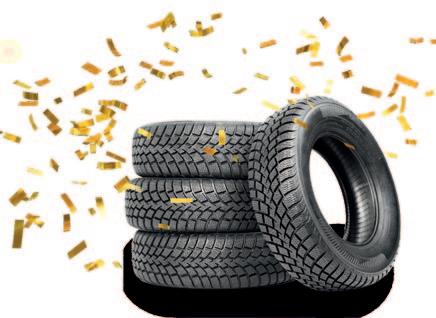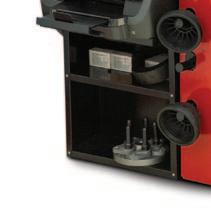






























































































































































































































1178
P: 289-887-4046
E: amoffatt@otda.com (General)
E: accounting@otda.com (Accounting) W: www.otda.com
Dundas St. Woodstock, ON N4S 1H5
P: 519-537-5596 1-866-534-0004
F: 519-537-8209
E: info@barneyprinting.com W: www.barneyprinting.com
The OTDA is recognized by industry and government as the representative body of the Independent Tire Dealers of Ontario.
Charley Kriksic, President Consumers Tire
Charmaine Carvalho, Vice President Chloride Canada




Rejean Murray, Secretary O.K Tire Service (Val-Rita)
Alexa Labrecque Provincial Tire Distributors
Bruce Barnim Tirecraft Ontario
Dan Bender Tire Discounter Group
Dave Byma Byma's Tire & Auto Servce
Eric Gilbert Ericway Tire
Erik Fielding Fielding Tire and Auto
Harold Boake Steelcase Tire
Jeremy Hanford Hanford's Tire & Service
Logan Shearer, Director Tirecraft Ontario
Ryan Burke, Director The Tire Terminal
Adam Moffatt, Executive Director OTDA If you're not receiving regular OTDA emails, make sure we have your current email address!












Interested in Shaping the Future of Ontario’s Tire Industry?

Over 2,200,000 sq. ft. of warehouse space and 2,500,000 tires in inventory!
• Fast delivery, simple & efficient service
• Intuitive, easy-to-use ordering platform
• Partnerships with a broad range of global manufacturers

Congratulations to our lucky winner!


In appreciation of our OTDAaf昀liated tire retailer partners, we are giving you the chance to win your tire purchase from Distribution Stox.
Until July 31st 2025, every purchase of tires from Distribution Stox by an OTDA member will be automatically entered with a chance to win their purchase. Every purchase from us is another chance to win!
Prize will be awarded in the form of a prepaid gift card by your local Distribution Stox Account Manager.



Although not mandatory in Canada, tire dealers should still feel an obligation to their customers to ensure TPMS systems are in working order before they leave the shop.
The tire industry is evolving, and so should your team. As the demand for high-quality service continues to rise, so does the need for well-trained, knowledgeable technicians. That’s why the Ontario Tire Dealers Association (OTDA) offers TIA’s Automotive Tire Service Training Programs — designed to enhance the skill set of your technicians and empower them to perform at their best.

Sometimes, this is easier said than done, especially if the customer refuses to have the work completed or if you don’t have a properly trained tire technician who understands TPMS.
Tire and wheel technology has become more advanced, and it’s more important than ever for technicians to stay up to date. This isn’t just about keeping pace with changes; it’s about ensuring your shop maintains the highest standards of quality and safety in an ever-evolving industry.
For shops not currently offering TPMS service work, this is an untapped revenue stream that should be considered. It still boggles my mind that a tire shop would send a customer to a competitor's location to perform TPMS service! In any event, a tire shop and technicians need to have access to current and up-to-date equipment, understand TPMS installation, and be trained on how to properly program sensors, systems and
The ATS Training Program provides your team with a deeper understanding of tire mounting, balancing, inflation, TPMS (Tire Pressure Monitoring Systems), and safety protocols that will prevent costly mistakes and improve overall efficiency.

Training your team not only benefits them personally but has a significant positive impact on your entire shop’s operation. Here are just a few of the advantages:

• Improved Productivity: Technicians who understand best practices perform faster and more efficiently, reducing downtime and improving the speed at which work is completed.
• Fewer Mistakes and Customer Complaints: Properly trained techs reduce the likelihood of errors and comebacks, ensuring a higher level of service and customer satisfaction.
• Enhanced Safety: Proper tire service requires the use of specific tools and safety techniques. Training reduces the risk of injury to both your staff and customers, protecting your reputation and keeping insurance costs down.
The OTDA lead Automotive Tire Service (ATS) Level 300 training course has 4 modules and hands-on training specifically covering TPMS.
• Stronger Employee Retention: Investing in your team’s education shows them that you’re invested in their success. This boosts morale and often leads to better retention, reducing turnover costs.
Technicians can expect to learn basic TPMS knowledge, system identification, system and sensor programming, system re-learn techniques and TPMS troubleshooting.
Training is about giving your staff the knowledge and confidence to do their job right the first time. For shop owners, this is an investment that pays off long term. You’re not only ensuring your team’s growth but also helping your shop grow by delivering the best possible service.
Not sure if your techs need training, ask them one simple question. “How many functions does the TPMS dash light have, and what are they?” If they didn’t know there are 2 functions, the telltale and malfunction indicator lamp, it might be time for a TPMS

The ATS Level 300 Training is now available to OTDA members at a discounted rate as announced in 2025. We are aiming to make training more affordable and within reach of all OTDA members.
Don’t wait until your shop faces avoidable mistakes — invest in your team and their education now.
Since tire dealers are expected to have a higher level of tire expertise than the average consumer, it is important that we ensure our staff is not only trained, but fully understands the requirements of today's cars, trucks and equipment.
If you'd like more details on upcoming training dates or have specific questions about the program, reach out to the OTDA.

additional inquires or to register for a class, email: amoffatt@otda.com





















In the competitive world of tire sales, it’s easy to fall into the mindset of simply moving product. While offering quality tires at competitive prices is essential, today’s customers are looking for more than just a transaction — they’re seeking confidence, knowledge, and value. The key to standing out isn’t just about what you sell, but how you sell it.
Customers often arrive at your shop with limited knowledge about tires, relying on your expertise to make informed decisions. This is your opportunity to shift from being a salesperson to a trusted advisor.
Take the time to explain the differences between tire brands, treads, and ratings. Highlight how factors like driving habits, seasonal conditions, and vehicle type influence tire performance. Offer insight into proper tire maintenance, including rotations, alignments, and inflation checks. By providing this knowledge, you empower your customers to make confident, informed purchases.
When customers feel valued and understood, they are more likely to return. Prioritize honest recommendations over upselling. If a customer doesn’t need a premium product, explain why a mid-range option might better suit their needs. Conversely, if a higher-end tire will provide better longevity and safety, ensure they understand the long-term value of their investment.


Consider implementing follow-up services, such as reminders for seasonal tire changes or free pressure checks. Providing educational content through emails, social media, or blog posts also keeps your brand top of mind and positions you as an industry expert.

Selling value goes beyond price. It’s about emphasizing the benefits your shop offers that others might not. Do you provide free tire rotations for a year with a purchase? Offer a robust warranty or convenient roadside assistance? Highlight these perks to show how your business adds value long after the sale is made.










Additionally, train your team to communicate these benefits effectively. Ensure they understand the unique selling points of your products and services so they can confidently share them with customers.






In an industry where competition is fierce, the businesses that stand out are those that prioritize knowledge and value. By positioning yourself as a trusted source of information and offering services that extend beyond the initial sale, you’ll build stronger relationships and establish long-term customer loyalty.

Remember, you’re not just selling tires — you’re selling confidence, safety, and peace of mind. And that’s a value no competitor can undercut.













As a key mode of transportation, no one wants their car to be stolen. Unfortunately, vehicle theft is still a prevalent issue. In fact, every year Équité Association releases a list of the top 10 stolen vehicles in Canada, highlighting which vehicles were targeted that year.
That’s why, whether you’re thinking about buying a new vehicle or keeping your current one, you may want to consider what steps you can take to prevent theft, and what you can do to ensure your vehicle is easily recovered should it be stolen. Below are some of our key tips for preventing vehicle theft.
1. Don’t leave your vehicle unattended while it’s running.
2. Don’t give thieves a reason to steal your vehicle by leaving valuables or spare change in your cup holder. If you must leave valuables in your vehicle, put them in the trunk or glove compartment where they are concealed.
3. Don’t leave your keys in the ignition, or your car’s key fob behind in the car when parked.
4. Don’t leave spare keys in the glovebox or another compartment. It might be convenient, but it’s not worth the inconvenience of having your vehicle stolen.
5. Consider using a steering wheel lock. Time is a factor for thieves; if it’s going to take them a little longer to steal your vehicle, it may deter them.
6. Park your vehicle in a garage.
7. Park in well-lit places. If possible, try to park in a secured lot with an attendant or security cameras.
8. Roll up the windows and make sure all doors are locked.
9. Arm your vehicle with a security system or buy a vehicle with a security system.
10. Make it harder for thieves to tow away your vehicle by using your emergency brake and turning your wheels to the side.
11. Install outdoor security cameras if you park outside.
12. Install an ignition kill switch if your vehicle doesn’t have a mandatory immobilizer.
13. Use a brake lock.
14. Check to see if your vehicle is one that is often targeted by thieves and if so, take extra steps to protect it.
If your vehicle ever does get stolen, the recovery process may be made easier if you’ve taken some key preventative steps:
1. Have your vehicle identification number (VIN) etched onto your windows. It will be more work for a thief to sell car parts and remove etchings.
2. Use GPS technology to track your vehicle if it does get stolen.
3. Leave a few business cards in your vehicle. It will help police identify who the vehicle belongs to or verify that you’re the owner.
1. Report the theft to the police. The sooner you report the theft, the higher the odds of it being recovered. They’ll ask you for details like:
• The year, make, colour, and model of your vehicle
• License number
• Vehicle identification number (VIN)
• Serial numbers of special equipment, if applicable
• Special markings, like previous damage, dents, and scratches
2. Take note of the police file number. When you make a claim, your insurer will ask for it.
3. Report your claim.
4. Arrange for alternative transportation.
5. Wait for an adjuster to get in touch with you.
6. Pay the deductible. Insurance may cover the remaining cost of repairs.

Whether you already own a vehicle or are thinking about purchasing one – taking proper precautions when it comes to your vehicle can help mitigate the likelihood of an unforeseen theft or break-in.
It’s also important to remember that company vehicles are also at risk of theft, and our vehicle theft prevention tips can also be applied to any commercial vehicles you or your employees use. That being said, even if you take all the necessary precautions, sometimes things can still go wrong. That’s why it’s vital that you also protect any commercial vehicles with the appropriate coverage. Without it, you may have to cover all the costs if you’re a victim of theft.










































By the Ontario Tire Dealers Association
Artificial Intelligence (AI) has become a buzzword in almost every industry— but for many independent tire dealers, it can feel like something meant for tech giants, not shops on Main Street. But AI isn’t just about robots or complicated software— it’s quickly becoming a useful, practical tool that businesses of all sizes can benefit from, including tire shops.
This article is a high-level introduction to AI—no jargon, no tech degree required. The goal is to help you understand what AI is, where it’s already showing up, and how you might consider using it to help your business run more smoothly.
At its core, AI is just technology that’s designed to make decisions or provide information based on data. Think of it like a really smart assistant—it doesn’t get tired, it learns as it goes, and it can often do repetitive tasks faster than a human.
Even if the term “AI” sounds unfamiliar or high-tech, chances are you’re already using it in your day-to-day life. If you’ve ever used voice assistants like Siri or Alexa, received a predictive text suggestion while typing a message, or had a GPS reroute you around traffic—that’s AI in action. Many of the apps and tools we rely on every day are already powered by AI, often quietly working in the background to make things smoother and faster.
Let’s look at a few practical examples of how AI is already starting to help small businesses—especially in the automotive and retail space.
AI-powered phone systems can now answer your shop’s phone, respond to basic questions, book appointments, and even send follow-up texts. This can reduce missed calls during busy times and free up your staff to focus on in-store customers.
AI chat tools on your website can help customers get quick answers—even after hours. They can check stock availability, provide basic tire info, or even guide customers toward booking an appointment. It’s like having someone at the counter 24/7.

Not sure what to post on Facebook or how to write a customer email? AI writing tools can help generate ideas or even create rough drafts of your promotions, announcements, or holiday hours—saving you time and helping you stay connected with your audience.
Another area where AI can help is in appointment scheduling and customer reminders. Tools powered by AI can learn your shop’s schedule patterns, suggest ideal time slots, and send automated reminders to customers—reducing no-shows and helping keep your day organized. Many of these tools integrate directly into systems you may already be using.
We know the tire business is built on relationships, trust, and hands-on service. AI isn't here to take that away. Instead, think of it as an extra set of hands that can handle some of the repetitive or behind-the-scenes tasks—so your team can stay focused on serving the customer and growing the business.
By the Ontario Tire Dealers Association
If this is the first time you’re hearing about using AI in a tire shop, don’t worry. You don’t need to make big changes overnight. Start by learning. Ask questions. Maybe test a call-answering service or try an AI-powered writing tool the next time you’re stuck drafting a promo or social media post.
As the industry continues to evolve, tools like these may help smaller businesses stay competitive, responsive, and ready for the next generation of customers.

Market trends are showing that AI is beginning to have a significant impact on driving car count, potentially outpacing traditional and digital marketing investments, while also improving customer service and saving valuable time for your team.
Now may be the time to consider exploring how AI could become a competitive advantage for your business.


By The Workplace Safety & Prevention Services (WSPS)

Picture this: A worker squats to the ground to pick up a tire, keeping their knees bent and back straight. But the tire is too heavy, and the worker doesn’t have the leg strength to get back up. To compensate, the worker uses back muscles and the spine to lift, ultimately injuring that vulnerable area.
Incidents like this are everyday occurrences in tire dealerships and help explain why WSIB claims for musculoskeletal disorders (MSDs) related to manual materials handling remain at a very high 28 percent. It’s also why the Ministry of Labour, Immigration, Training and Skills Development (MLITSD) is running an inspection campaign from June 2, 2025, through to March 31, 2026, focused on reducing these hazards.
Let’s break down what went wrong in the scenario above. “In this case, the worker had some very basic training to ‘keep your back straight and bend your knees,’ but it wasn’t enough,” says Don Patten, WSPS Specialized Services Lead (Ergonomics).
“There are eight additional elements involved in a safe lifting technique. In addition, there are alternative ways to lift besides a squat. This worker needed training and practice on the full range of elements, as well as knowledge about when an alternative lift, such as a lunge lift or deadlift, might be more appropriate and safer.”
Continued on page 28


















Looking to upgrade some of your shop equipment for the 2025 Season? Take advantage of our limited time special offer!

CANADIAN OWNED & OPERATED Over 60 Locations - Find your APC today!








*Minumum order required











Must be a member of OTDA. Offer valid until August 31, 2025. Cannot be redeemed for cash. Offer subject to change. $500 off will be applied to equipment orders over $5000 only. Ask our Sales team for a full list of qualifying suppliers. Order must be placed at your nearest APC Auto Parts Centres store. Financing available.













The handling of materials—whether receiving, storing, stacking, or moving—is a daily activity in every tire shop. Without proper practices, these tasks can result in strains, injuries, or more serious incidents. From June 2, 2025, through March 31, 2026, the Ministry of Labour, Immigration, Training and Skills Development (MLITSD) will be conducting a focused inspection campaign targeting retail workplaces, including tire dealerships.
All OTDA Members are advised to review and reinforce their safe material handling procedures.
For more information and recommendations, visit: www.wsps.ca/resource-hub/home/retail-inspections
Continued from page 26
"We know that using correct postures and movements while lifting minimizes the stress and load on the spine and other joints," says Don. Here are his 10 tips for postures and movements, and why they are important.
1. Have a stable base of support. "Position feet shoulder-width apart, one foot slightly in front of the other. This improves balance and stability and prevents the person from falling over or applying weight unevenly on their back."
2. Hold the load as close to the body as possible. Somewhere between the shoulder and waist is ideal. "This helps reduce the strain on the lower back which can lead to injury."
3. Keep the natural curve in the back. "This way, the mechanical force will be distributed more evenly over the spine."
4. Bend the knees. "The leg muscles will take the load, not the spine."
5. Co-contract stomach and back muscles. "This puts the person in a good lifting position and offers protection to the spine."
6. Keep shoulders back. "Rounded shoulders while lifting puts stress on the shoulder joints, which can lead to pain in the upper back and neck."
7. Stick buttocks out. "This helps to prevent the pelvis from tucking under and the back from rounding - postures that will increase the overload on the lower back when lifting."
8. Get a good grip on the object. “A loose grip can cause a person to lose balance, twist, suffer a strain or be struck by the object."
9. Use thigh and buttock muscles to lift. "The movement should be in your legs, not your back."
10. Breathe, and relax your muscles. "Not breathing during a lift can increase intra-abdominal pressure and the potential for injury. Likewise, tense muscles make it more difficult to lift because the muscles are already working."
By staying proactive and prioritizing safe material handling practices, tire dealers can protect their teams, avoid costly injuries, and stay prepared for upcoming inspections. A safer workplace is a stronger business.














❏ No Fees, No Penalties, No Contracts
❏ It is Easy to enroll with 1 simple phone call!
❏ Members will receive the knowledgeable support of our Customer Care Representatives, and the personal attention of a dedicated Staples Onboarding Specialist
❏ Web based and phone ordering systems
❏ Over 300,000 products to choose from, which includes paper, ink/toner, stationary basics, furniture, technology, breakroom/kitchen, cleaning/sanitation, safety apparel/equipment and health/medical supplies, retail store supplies/display, personal care, household items
❏
when purchasing items in the Bulk Centre
❏ 10% savings on Copy, Print & Marketing Services
❏ Buy on-line, Pick up at store (BOPIS) and of course the Fast, Next Business Day Shipping on all orders placed before 5:00PM local time
❏ available depending on size of order)
❏ UseVisa, MasterCard, American Express or Staples Account as Method of Payment for Orders
❏ Earn Basic and Bonus Air Miles reward miles










TPMS
Tire
Automotive
Service
Wheel
Air/Cordless
Wheel Weights & Balancing Beads
Shop









